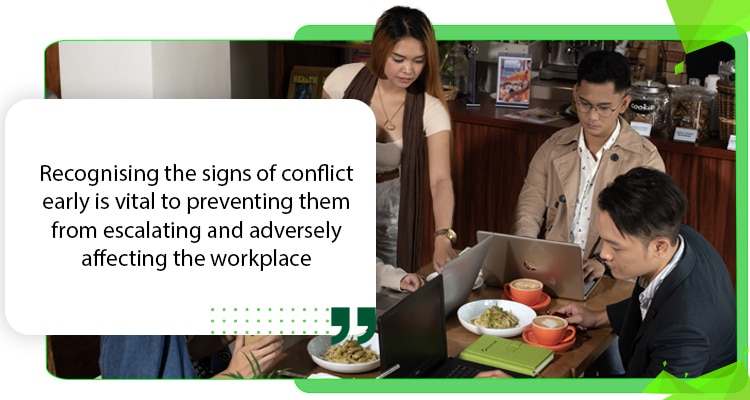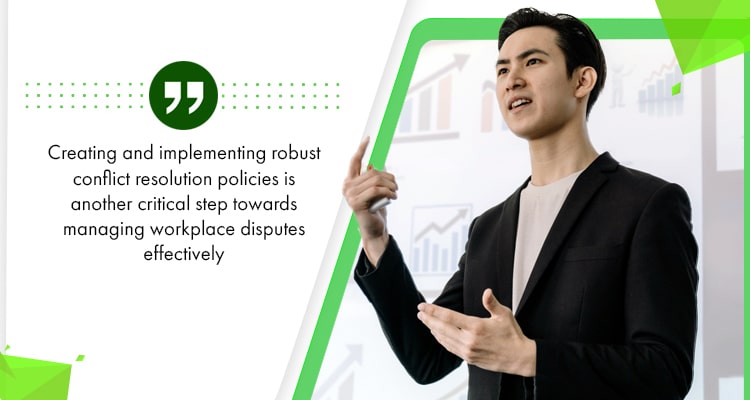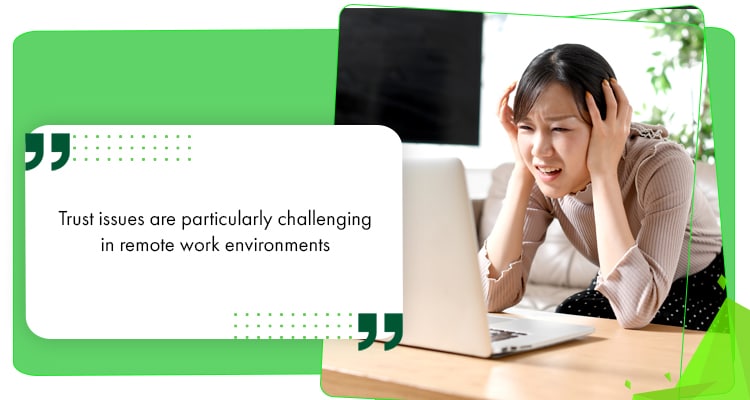Workplace conflicts are inevitable in any organisation, arising from different factors like differences in opinions, miscommunications, or competition over resources.
Effectively managing these conflicts is important for sustaining a productive and harmonious work environment.
Read here to understand more about the causes of team conflicts and why it’s important to address them properly.
Why Do Workplace Conflicts Occur?
For you to handle workplace conflicts effectively, it is essential to understand their root causes and their impact.
Workplace conflicts are the result of various factors:
Miscommunication: Misunderstandings due to poor communication.
Poor communication is the most common culprit behind workplace conflicts.
Misunderstandings can arise from:
- Unclear instructions
- Lack of feedback
- Misinterpreted information
Different Values: Conflicting personal values or ethics.
Individuals bring their own set of values and ethics to the workplace, which can sometimes clash with those of their colleagues or the organisation’s.
Perceived Lack of Fairness or Transparency.
The lack of opportunities for advancing one’s career or sharing limited resources can create tensions between employees e.g. unfair competition: the scarcity of promotions, recognition, or resources can increase the incidence of unethical behavior amongst peers in the workplace.
Conflict also typically happens in work environments with a Personality Clashes: Irreconcilable differences leading to disagreements.

When team members have opposing personalities, it can lead to misunderstandings and disagreements, particularly if there is a lack of respect or understanding.
Work Style Differences: Variations in how people approach work.
Diverse approaches can enhance a team’s performance but can also lead to conflicts if not managed well.
Differences in how team members manage their time, prioritise tasks, or approach problem-solving can create friction.
Why is Managing Workplace Conflicts Important?
Effectively managing workplace conflicts restores peace and most importantly, fosters an environment where all employees can thrive.
Impact on Productivity
Unresolved conflicts can significantly hinder productivity.
Having to constantly watch your back can lead to:
- Delays in project completion
- Numerous errors
- Compromised time management
Employee Morale
Conflicts can severely affect employee morale.
Ongoing disputes can increase turnover rates and may lead to:
- Job dissatisfaction
- Increased stress
- A negative workplace atmosphere
Organisational Health
Peace and order within the workplace depend on how effectively your organisation’s leaders manage conflicts.
A healthy workplace is one where conflicts are resolved constructively, fostering a culture of collaboration and mutual respect.

Effective conflict management can prevent disputes from escalating and affecting the broader workplace.
Unresolved conflicts can detrimentally impact organisational health by:
- Decreasing communication and trust
- Creating a toxic work environment
- Reducing job satisfaction and productivity
- Increasing employee turnover
Types of Workplace Conflict
Navigating workplace conflicts is an inevitable part of any professional environment.
Recognising the types of conflicts helps you address them effectively to restore a harmonious (and productive) work environment.
Interpersonal Conflicts
Interpersonal conflicts arise when individuals clash due to:
- Personal differences
- Miscommunication
- Conflicting values
These disputes can be particularly disruptive as they affect the emotional and psychological well-being of those involved, leading to tension within the team.
Intragroup Conflicts
Intragroup conflicts occur within a single group or team, typically stemming from disagreements over:
- Work responsibilities
- Project goals
- Decision-making processes
These conflicts can hinder collaboration and affect the team’s ability to achieve its objectives efficiently.
Intergroup Conflicts
Intergroup conflicts happen between different groups or departments within an organisation.
Often linked to competition for resources or conflicting objectives, these disputes can escalate quickly if not managed properly.
Signs of Workplace Conflicts
Recognising the signs of conflict early is vital to preventing them from escalating and adversely affecting the workplace.
Behavioural Changes
One of the first signs of conflict is a change in employee behaviour that might include:
- Increased instances of arguments
- Withdrawal from participation
- Overt expressions of dissatisfaction and frustration

Decreased Productivity
When teams are embroiled in conflict, productivity often suffers.
The focus shifts from getting work done to having to watch their backs, leading to:
- Delays
- Missed deadlines
- Subpar performance
Increased Absenteeism
An uptick in absenteeism can also indicate unresolved conflicts.
Employees may start taking more sick days or personal leave to avoid tense situations, which can further strain the team and hamper the continuity of their workflow.
How to Resolve Workplace Conflicts
Effectively resolving conflicts is key to restoring and maintaining a productive and positive work environment.
Open Communication
Promoting open communication is essential to conflict resolution.
Creating a culture that cultivates open, healthy dialogue can prevent many disputes from arising and help resolve other issues.
And speaking of dialogues…

Encourage Honesty and Transparency
Create a safe environment for employees to express their concerns without fear of repercussion.
Facilitating open discussions helps you understand the root causes of conflicts to find mutual ground.
Active Listening
When managing conflicts, listen to all parties involved without interruption.
To understand each person’s perspective, listen with the intent to understand rather than to respond. This is key to get the insight you need to resolve disputes fairly and effectively.
Clarify and Confirm
To guarantee that all parties are on the same page, it’s helpful to have a recap of the discussion.
This practice can lead to a better and mutual understanding and help ease tensions.
Mediation and Facilitation
When moving from understanding and identifying conflicts to actively resolving them, mediation and facilitation play critical roles.
These involve structured, guided interactions that aim to resolve disputes amicably and effectively.
Neutral Mediator
Employing a neutral third party to mediate conflicts can help maintain objectivity.
A mediator facilitates discussions so that all parties are heard without bias, which can significantly ease tensions and lead to mutual understanding.
Structured Meetings
Conducting structured meetings where each party has the opportunity to present their viewpoint is another effective strategy.
This formal setting guarantees that discussions remain focused and productive, with each participant having equal time to share their side of the story.
Facilitation Techniques
Using facilitation techniques during these meetings can guide the conversation towards resolution.
Techniques may include:
- Setting ground rules
- Using visual aids to map out disagreements and understandings
- Actively managing the pace of the meeting to keep discussions constructive
Collaborative Problem-Solving
After laying the groundwork through effective mediation, transitioning to collaborative problem-solving can yield practical solutions to workplace conflicts.
Identify Common Goals
Focusing on shared goals and interests helps find common ground among conflicting parties.
It shifts the narrative from confrontation to collaboration, making it easier to address the underlying issues.
Brainstorm Solutions
Encouraging brainstorming sessions allows all parties to contribute creative solutions.
This inclusive approach can uncover innovative ways to resolve conflicts that might not be as apparent in a more confrontational setting.
Agree on Action Plans
Finally, establish a plan that outlines the steps each party will take to resolve the conflict that can solidify the agreement.
This plan should include clear responsibilities, timelines, and follow-up measures to guarantee conflict resolution and prevention.
Training and Development
Investing in the right training and development enhances conflict management within the workplace.
These equip employees and leaders with the necessary tools and skills to handle disputes effectively and foster a positive work culture.
Conflict Resolution Training
The right resolution training programs can empower employees to address and resolve most common conflicts with little to no direct intervention from management.
Examples of conflict resolution training typically cover strategies like:
- Mediation focuses on the art of mediating disputes between parties, teaching participants how to facilitate discussions and work toward a solution.
- Negotiation involves understanding and articulating their own needs while also recognising and respecting the needs of others.
- Problem-solving enhances participants’ ability to identify the root causes of conflicts and develop logical and creative solutions.
Leadership Development
Training leaders to handle conflict effectively is essential.
After all, it’s part of a leader’s job to manage disputes efficiently and model the right behaviour for a respectful and collaborative work environment.
Communication Workshops
Organising workshops to enhance communication skills across the organisation can significantly reduce misunderstandings that lead to conflicts.
These workshops focus on elements that are vital in preventing workplace disputes, such as:
- Active listening teaches participants how to listen intently to what others are saying without the purpose of responding but to understand the speaker’s perspective.
- Clear messaging emphasizes the importance of conveying information clearly and effectively.
- Non-verbal communication cues help participants become more aware of their own non-verbal cues and more sensitive to others’ cues for smoother interactions.
Implementing Conflict Resolution Policies
Creating and implementing robust conflict resolution policies is another critical step towards managing workplace disputes effectively.
Developing Policies
Clear guidelines and procedures help standardise the management of conflicts for a fair and consistent handling of all cases.
Clear Guidelines
Developing clear guidelines for resolving conflicts provides a transparent framework that helps prevent disputes from escalating.
These guidelines outline acceptable behaviours and the steps to take when a conflict arises.
Step-by-Step Procedures
Outlining step-by-step procedures provide a clear guide on how to proceed when employees encounter a dispute.
This helps manage expectations and provides a clear path to resolution.
Roles and Responsibilities
Analyse the roles and responsibilities of all parties involved in conflict resolution so that everyone knows their part in the process.
Knowing your role can streamline or expedite resolution and reduce confusion.
Training and Awareness
Effective conflict resolution policies are vital, but their success ultimately depends on thorough training and awareness among all employees.
Policy Awareness and Training
Regular onboarding and ongoing training sessions keep all employees updated on conflict resolution strategies and workplace policies.
These sessions reinforce standards and procedures and serve as refreshers for continuous and effective dispute handling.
Feedback Mechanisms
Implementing effective feedback mechanisms is key to continually improving the conflict resolution process.
These mechanisms allow employees to provide anonymous feedback on the effectiveness of the dispute resolution procedures and suggest improvements.
This helps refining the processes and makes employees feel involved and invested in conflict management.
Best Practices for Preventing Workplace Conflicts
Preventing conflicts from arising in the first place is just as important (or perhaps even more so) as effectively managing them.
Foster a Positive Work Environment
Creating a supportive and positive work environment is key to preventing many workplace conflicts.
This can be achieved through various strategies, like the ones below:
Encourage Team Building
Organising regular team-building activities can strengthen bonds and improve rapport among colleagues, reducing the likelihood of conflicts.
Promote Diversity and Inclusion
Fostering a culture that values diversity and inclusiveness promotes mutual respect and understanding across different perspectives.
Recognize and Reward Employees
With a consistent and strong recognition and reward system in place, team members will feel valued and appreciated.
A fair and consistent reward system is essential for maintaining a harmonious workplace where the right values are upheld, thus helping to foster mutual respect among employees.
Effective Leadership
Leaders play a critical role in preventing and resolving conflicts by setting the tone for the workplace environment.
Lead by Example
Leaders should demonstrate positive behavior and effective conflict resolution skills, setting the standard for the rest of the team.
Provide Clear Expectations
Clearly communicating job roles, responsibilities, and expectations can prevent misunderstandings.
This strategy helps align all team members with their objectives.
Be Approachable
Maintaining an open-door policy encourages employees to voice their concerns early on, preventing minor grievances from escalating.
Addressing Trust Issues in the Remote Workplace
Trust issues are particularly challenging in remote work environments, where physical distance can lead to misunderstandings and feelings of isolation.

Addressing these issues effectively requires targeted strategies:
- Consistent Communication. Regular updates and open channels for feedback help maintain clarity and prevent misunderstandings.
- Transparency. Sharing the rationale behind company decisions and encouraging constructive dialogue can reinforce trust among team members.
- Clear Expectations. Clearly defining roles, responsibilities, and deliverables so all team members know what is expected of them and how they fit into the organisational goals.
- Regular Feedback. Providing constructive feedback and recognising accomplishments can boost morale and strengthen trust.
Implementing these strategies can help create a more trusting and cohesive remote work environment.
FAQs
Here are the most frequently asked questions about specific strategies and best practices that can improve conflict resolution in your organisation.
Q1: What is the first step in resolving a workplace conflict?
The initial step in resolving a workplace conflict is to thoroughly identify the root cause of the conflict.
This involves listening attentively to all parties involved to understand their perspectives and grievances fully.
It’s necessary to gather as much information as possible to accurately address the underlying issues.
Q2: How can open communication help in conflict resolution?
Open communication enables all parties to communicate their views freely.
This approach helps identify shared concerns to work towards a common solution, making it easier to find a mutually acceptable resolution for all parties.
Q3: Why is mediation important in conflict resolution?
Mediation is vital in conflict resolution as it provides a neutral setting where all parties can discuss their issues openly and honestly under the guidance of a mediator.
This process makes sure each side is heard and understood, and it supports the exploration of solutions that address the needs and interests of all involved.
Proper mediation can lower tensions and facilitate a structured dialogue for a thorough and peaceful resolution.
Time to Apply What You’ve Learned
Successfully managing workplace conflicts is important for fostering a positive and productive work environment.
By embracing strategies such as open communication, structured mediation, and ongoing training, organisations can resolve disputes effectively and strengthen workplace harmony.
How would you implement these practices to turn challenges into opportunities for growth and maintain a healthy organisational culture?
- Want specific AI Prompts to help you automate processes? Get the Full AI list here.
- How about a list of the Top Business Apps that could take your company to the next level this 2024? Head over here.
- Whenever you are ready to Hire World-Class, High Performing, Full-Time Virtual Staff at 40%-60% Cost Savings with Lifetime Support head over here.
- View our 1,000 Fully vetted, highly talented virtual staff who can take the more tedious tasks off your hands here.
Darren Aragon is a multifaceted writer with a background in Information Technology, beginning his career in research at Pen Qatar and transitioning through customer service to a significant role at Absolute Service, Inc. His journey into freelance writing in 2021 has seen him excel across various niches, showcasing his adaptability and deep understanding of audience engagement.




















